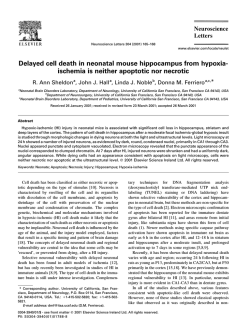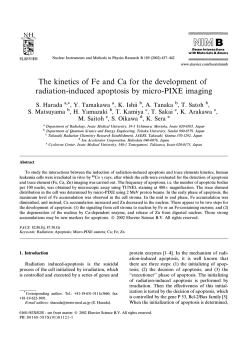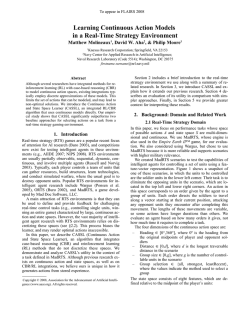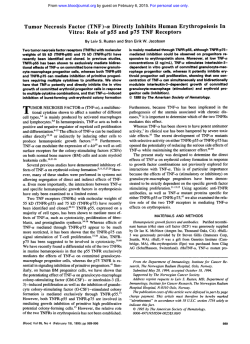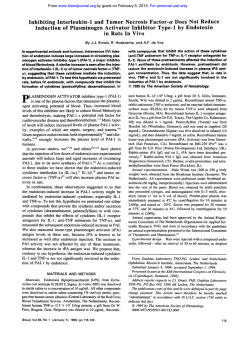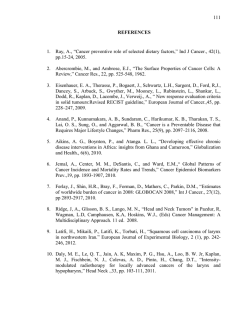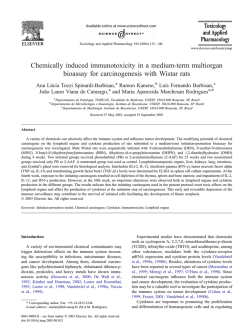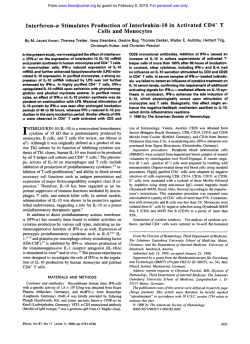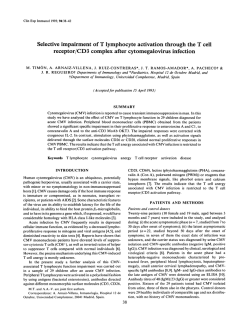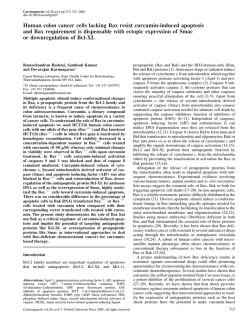
Inhibition of CD4 Cross-Linking-Induced Lymphocytes
From www.bloodjournal.org by guest on February 6, 2015. For personal use only. Inhibition of CD4 Cross-Linking-Induced Lymphocytes Apoptosis by Vesnarinone as a Novel Immunomodulating Agent: Vesnarinone Inhibits Fas Expression and Apoptosis by Blocking Cytokine Secretion By Naoki Oyaizu, Thomas W. MCCloskey, Soe Than, and Savita Pahwa Evidence is accumulatingthat T cellsfrom human immunodeficiency virus type 1 (HIV-l)-infected individuals showacceleratedcell death through apoptosis. We have recently demonstrated that the cross-linking of CD4 molecules (CD4XL) resultsin death of normal peripheral T cells through apoptosis and imbalanced cytokine secretion (ie, induction of tumor necrosis factor-cu [TNF-a1 and interferon-y [IFN-yl in the absence ofinterleukin-2[IL-21 or IL-4secretion). These upregulated cytokines (TNF-u/lFN-y) largely contributed to upregulation of the apoptosis-inducing cell surface molecule, Fas(APO-I/CD95) and apoptosis induction. The present study investigated the effect of vesnarinone as a novel immunomodulatingagent on CD4XL-induced T-cell apoptosis. The addition of vesnarinone to peripheral blood mononu- clearcells(PBMC) significantly inhibited CD4XL-induced lymphocyteapoptosis.Thisapoptosis-inhibitoryeffectof vesnarinone was associated with the blocking ofCD4XLinduced TNF-(U and IFN-y secretion andof Fas antigen upregulation. However, vesnarinonedid not block effectsof exogenously supplemented TNF-cu/lFN-y on Fas induction. These data suggestthat vesnarinone inhibits CD4XL-induced TNFcu/lFN-y secretion,thereby blocking subsequentFas upregulation and apoptosis induction. Given the potent pathogenic role of imbalanced cytokine secretion observed in HIV-infection, an agent such as vesnarinone may be of therapeutic value in slowing disease progression. 0 7996 by The American Society of Hematology. T performed in PBMC in vitro, could be one possible explanation for the discordant cytokine upregulation and accelerated apoptosis observed in HIV-infected individuals. Our findings suggest that therapies aimed at controlling aberrant cytokine secretion should prove beneficial in patients with HIV infection. Here we report that vesnarinone inhibits CD4XL-induced events, which include ( l ) TNF-a and IFN-y secretion; (2) Fas upregulation, and (3) apoptosis induction. Vesnarinone did not block the Fas induction in lymphocytes resulting from exogenously provided TNF-aIIFN-y. These data suggest that vesnarinone may inhibit apoptosis induction by suppressing cytokine secretion and subsequent Fas upregulation, which are prerequisite events in T-cell apoptosis induction. HE LIMITED SUCCESS of nucleotide reverse transcriptase inhibitors in human immunodeficiency virus type 1 (HIV-l)-infected patients has shifted attention to the development of drugs that use alternative targets. An oral inotropic agent, vesnarinone (3,4-dihydro-6-[4-3,4-dimethoxybenzoy1)-l-piperazinyl1-2(1H)-quinolinone),has recently been shown to exert potent antiviral and anticytokine activities. Vesnarinone has been found to inhibit replication of HIV-I in vitro without affecting reverse transcriptase or retroviral proteinase activity.' Vesnarinone was also found to inhibit lipopolysaccharide (LPS)-induced tumor necrosis facto-a (TNF-a) and interleukin-6 (IL-6) secretion and phytohemagglutinin (PHA)-induced interferon-y (IFN-y) and granulocyte/monocyte colony stimulating factor (GM-CSF) secretion by peripheral blood mononuclear cells (PBMC).'.' The immunopathogeneic events from the time of initial infection with HIV until the global deterioration of the immune system, including destruction ofCD4' T cells, are complex and involve aberrant activation of the immune system and cytokine secretion. A number of laboratories have reported that T cells from HIV-infected individuals undergo enhanced apoptotic cell death."7 Considering the fact that productively infected cells are barely detectable in peripheral c i r ~ u l a t i o ndirect , ~ ~ ~ cytopathic effect of HIV cannot account for the observed substantial degree of apoptosis; rather the operation of a mechanism for elimination of noninfected cells is more probable. In this regard, we have recently shown that the ligation of CD4 molecules and CD4 crosslinking (CD4XL) resulted in the induction of IFN-y and TNF-a secretion in PBMC, and these induced cytokines contributed largely to the upregulation of Fas (APO-I/CD95), a cell surface apoptosis-triggering molecule'0,'' and to apoptosis ind~ction.~.''This discordant cytokine profile induced by CD4XL agrees with that actually observed in HIV infe~tion.""~ Considering the fact that some level of plasma viremia is always detectable" and that lymph nodes harbor a heavy viral l ~ a d , ' ~the . ' ~ likelihood of CD4XL occurring in vivo in CD4 antigen bearing cells as a result of highaffinity binding of gp120 to CD4, is extremely high in HIV infection. Thus, aberrant cytokine induction as a result of CD4XL occurring in vivo, similar to that seen with CD4XL Blood, Vol 87, No 6 (March 15), 1996: pp 2361-2368 MATERIALS AND METHODS Cells and culture conditions. PBMC were obtained from HIVseronegative healthy donors. PBMC were isolated from heparinized venous blood by Ficoll-Hypaque density gradient centrifugation. PHA-induced CD4+ T-cell clones were established and maintained as described.*' The clones were maintained by the cyclic stimulation of PHA-P (5 pg/mL, Difco, Detroit, MI) for 3 days followed by 3 days rest in the presence of irradiated (3,000 rads) autologous Epstein-Barr Virus (EBV)-transformed B cells. RPM1 1640 (GIBCO From the Department of Pediatrics, North Shore University Hospital-Cornell University Medical College, Manhasset, New York, NY. Submitted June 12, 1995; accepted October 25, 1995. Supported by grants from Otsuh Pharmaceutical (Palo Alto, CA) to S.P. and National Institutes of Health (Bethesda, MD) Grant No. AI28281. Address reprint requests to N. Oyaizu, MD, Room 303, Biomedical Research Building, NSUH-CUMC, 350 Community Drive, Manhasset, New York, NY 11030. The publication costs of this article were defrayed in part by page charge payment. This article must therefore be hereby marked "advenisement" in accordance with 18 U.S.C. section 1734 solely to indicate this fact. 0 1996 by The American Society of Hematology. 0006-4971/96/8706-0012$3.00/0 2361 From www.bloodjournal.org by guest on February 6, 2015. For personal use only. 2362 Laboratories, Grand Island, NY) supplemented with 10% heat-inactivated FCS (GIBCO), 2 mmoUL L-glutamine (Whittaker Bioproducts, Inc, Walkersville, MD), 100 U/mL penicillin G, and 100 pg/ mL streptomycin was used for all cultures. Antibodies and reagents. Reagents and sources were as follows: vesnarinone (OPC-8212, Otsuka Pharmaceutical CO,Tokushima, Japan); cyclosporin A (CsA, Sandoz, East Hanover, NJ); monoclonal antibody (MoAb) to CD4 (Leu3a; IgGl, Becton Dickinson, Mountain View, CA, OKT4; IgG2b, Ortho Diagnostic System, Inc, Raritan, NJ); MoAb toCD3 (IgG2a, MAb 454,22 a gift from Dr N. Chiorazzi, North Shore University Hospital, Manhasset, NY); and goat antimouse immunoglobulin, (GAM; Tago, Inc, Burlingame, CA). Recombinant human IFN-y (rlFN-y) was obtained from Genzyme (Cambridge, MA); recombinant human TNF-a (50 units/ng as determined by half-maximal cytotoxicity of L929 cells) was a kind gift from Dr K.J. Tracey (Picower Institute, Manhasset, NY). induction of CD4 cross-linking (CD4XL). Induction of CD4XL were performed as described.’*In brief, cells were treated with Leu3a or OKT4 at concentrations of 3 pg/2 X IOh cells/mL for 1 hour at 4°C. Cells were then cultured in 24-well Nunc plates (Nunc, Roskible, Denmark) coated with goat antimouse immunoglobulin (GAM) at 37°C. Various doses of vesnarinone or CsA (400 ng/mL) were added at the time of culture initiation at 37°C and were present throughout the culture period. Vesnarinone was initially dissolved in I N HCI, diluted 1:lO in serum-free RPMI, and the pH was adjusted with IN NaOH to 7.0 just before addition to cell cultures. CsA was used as a control agent. We confirmed that reagents used for CD4XL. which include OKT4, Leu3a, and GAM, are free from endotoxin as determined by the Limulus amebocyte lysate assay (ETOXATE, Sigma),which had an endotoxin detection limit of O. 125 EU/mL. lmrnunoffuorescence stainingand $ow cytometry. For study of cell surface expression of Fas, cells were stained with fluorescein isothiocyanate (F1TC)-conjugated anti-Fas MoAb (clone UB2 IgG 1, AMAC Inc, Westbrook, ME). FITC-conjugated mouse IgGl antibody (AMAC) was used as a control. In some experiments, antiFas stained cells were subsequently stained with Per-CP-conjugated anti-CD3 MoAb (Becton Dickinson). All incubations of cells with antibodies were for 10 minutes at room temperature followed by washing with Hanks’ Balanced Salt Solution (HBSS) and fixing in Immunoprep C (Coulter, containing 1% [wtlvol] paraformaldehyde). The stained cells were analyzed on a flow cytometer (Epics Elite, Coulter Electronics). A lymphocyte gate was first drawn on a histogram of forward versus right angle light scatter. This gate, which excluded debris, monocytes, and clumps, was assigned to a histogram of red fluorescence. On this histogram, appropriate gates were drawn to capture certain populations (CD3’, CD3-l as required. Fluorescence emissions were collected at 525-nm for FITC (green) and 675-nm for Per-CP (red), respectively. Single parameter green histograms representing Fas expression in each gated population were evaluated by comparing them with the isotypic controls using Coulter’s cytologic analysis program (Overton’s Cumulative Subtraction Algorithm: OVERSUB) which was implemented to assess percent of cells positive for Fas expression over control. Meusurement of upoptosis byftow cytonretry. The percentage of cells undergoing apoptosis was quantitated by a modification of the flow cytometric method as described.23Briefly, 2 X IO6 cells were fixed in 75% ethanol for 1 hour at 4°C. The cells were then washed and resuspended in 0.5 mL HBSS. To this suspension, 0.5 mL RNase solution (1 mg/mL HBSS) was added followed by 1 mL propidium iodide (PI, 100 pg/mL HBSS, Molecular Probes, Eugene, OR). After gentle mixing, cells were incubated for 72 hours at 4°C in the dark. The PI fluorescence of individual cells was measured using a flow cytometer. Cell debris and cell clumps were excluded by gating for single cells under forward and side light scatter. A distinct cell cycle OYAIZU ET AL region of apoptosis (Ao) could be identified below the G,JG, diploid peak. Percentage of cells in the Ao region were estimated. Cell death was also evaluated by trypan-blue exclusion. Determination of cytokineconcentrationsandcytokine mRNA. The culture supernatants were collected after 48 hours and cytokine concentrations were quantitated by using commercial enzyme-linked immunosorbent assay (ELISA) kits (Genzyme) according to the manufacturer’s instructions. For the quantitation of cytokine mRNA, polymerase chain reaction (PCR) assisted mRNA amplification reverse transcriptase (RT-PCR) was employed as described elsewhere.24In brief, cells were collected after a 6-hour culture, and total cellular RNA was extracted with RNAzolB (Cinna/Biotecx, Houston, TX) according to the manufacturer’s protocol. Reverse transcription of RNA to cDNA was performed according to GeneAmp RNA PCR kit protocol (Perkin Elmer Cetus, Nonvalk, CT). Cytokine specific primer pairs and @-actin were purchased from Research Genetics (Huntsville, AL). Primer sequences were the same as those described elsewhere (IFN-y, @-actin,24TNF-a2’). PCR was performed in a GeneAmp PCR system 9600 (Perkin Elmer Cetus) for 30 cycles: 1 minute denaturation at 9 4 T , 1.S minutes annealing at SS”’, and 1 .S minutes extension at 72°C. A final extension period of 10 minutes followed the 30 cycles. @-actinwas used as an internal control in all reactions. The reaction products were visualized by subjecting them to electrophoresis in 1% agarose in 1 X TBE buffer containing 0.5 pg/mL ethidium bromide, followed by transfer to nylon membranes, hybridization with ’*P-labeledsense primers, and exposure to x-ray film. Stutisticul unalysis. Statistical significance was assessed by Student’s t-test. RESULTS Vesnarinone blocks CD4XL-induced lymphocyte apoptosis. As shown in Fig l and Table 1, we confirmedthe observation that CD4XL resulted in a significant increase of lymphocyte apoptosis as determined by cellular viability and by demonstration of the emergence of sub-GdG, peak nuclei (Ao cells) on flow cytometry. We have previously confirmed that the majority of cells undergoing apoptosis are composed of CD3’ T cells.’ Vesnarinone was found to inhibit CD4XLinduced lymphocyte apoptosis in a dose-dependent manner. Significant inhibition was observed at concentrations of > I O ,ug/mL, and this was associated with a significant increase of cellular viability. A comparison was made between vesnarinoneand the well-characterized immunosuppressive agent, cyclosporine A (CsA), which also inhibited the CD4XL-induced apoptosis. Vesnarinone, by itself, was not cytotoxic up to 100 pg/mL (data not shown). Vesnarinone blocks CD4XL-induced TNF-a and IFN- y secretion. We have previously demonstrated that CD4XL results in aberrant cytokine secretion in PBMC, in that cytokines TNF-(Yand IFF-y were induced in the absence of IL-2 and IL-4.” Moreover, these induced cytokines were determined to largely contribute to apoptosis-induction in lymphocytes, which was associated with upregulation of Fas antigen expression. We therefore examined the effect of vesnarinone on CD4XL-induced TNF-a and IFN-y secretion. As shown in Table 2, the addition of vesnarinone significantly inhibited CD4XL-induced TNF-a and IFN-7 secretion. The inhibitory effect mediated by vesnarinone was concentration-dependent and showed a similar dose-response to that required for apoptosis inhibition. CsA was From www.bloodjournal.org by guest on February 6, 2015. For personal use only. 2363 INHIBITION OFLYMPHOCYTEAPOPTOSISBYVESNARINONE U 3. CMXL Fig 1. Vesnarinone blocks CD4 cross-linking (CD4XL)-inducedapoptosis. CD4XL was performed in normal PBMCs as described in Table 1, and cells were cultured in the presence of various concentrations [pglmL) of vesnarinone (Ves) indicated for 3 days. Cellswere stained with PI andanalyzedby flow cytometry. A distinct region of A0 (marked Dt could be identified below the GolGl peak. Percentage of cells found in found in the Ao peak l%Aol are indicated. 6 , ;S \&\ L k PI fluorescence also found to block CD4XL-induced TNF-a and IFN-y secretion. We next examined whether vesnarinone affects the CD4XL-induced TNF-a and IFN-y mRNA accumulation (Figs 2 and 3). For this purpose, we performed RT-PCR using mRNAs extracted from CD4 cross-linked PBMC in the presence or absence of vesnarinone. At concentrations that significantly blocked cytokine secretion, no discernable effects were noted on CD4XL-induced TNF-a (Fig 2, lane 3) and IFN-y (Fig 3; Exp. 1, lane 3; Exp. 2 , lane 3) mRNA accumulation by vesnarinone (cytokine values obtained from identical samples used for RT-PCR are indicated in inset tables in Figs 2 and 3). In contrast, CsA blocked both I F N y mRNA accumulation and IFN-7secretion (Fig 3, lane 4). Table 1. Vesnarinone Blocked CD4 Cross-Linking Induced LymphocyteCell Death Treatment Addition (pg/mL) Medium Anti-CD4 MoAb alone GAM alone CD4XL + vesnarinone (3) + vesnarinone (10) + vesnarinone (30) + vesnarinone (60) CsA + % Viability 88.6 80.8 80.4 68.2 68.1 69.8 80.7 82.7 79.7 2 4.2 2 2 -c 2 2 2 2 2 5.0 4.7 5.7 4.9 7.5 4.5* 2.3* 4.1, Because we performed the CD4XL in unfractioned PBMC and because CD4 molecules are expressed in both T cells and monocytes, we examined the cellular source of TNF-a and IFN-y in response to CD4XL. As shown in inset tables in Figs 2 and 3, CD4XL of cloned CD4+ T cells in the absence of any accessory cells resulted in both TNF-a and IFN-y induction. Soluble anti-CD3 MoAb treatment of cloned T cells inthe presence of autologous EBV-transformed B cells was used as a positive control. These data indicate that T cells can be induced by CD4XL to secrete TNF-a and IFN-y in the absence of accessory cells. We have confirmed this observation using purified peripheral T cells and monocytes populations. Upon CD4XL, IFN-y induction was restricted to T cells, but TNF-a was inducible both from T cells and, to a lesser degree, from monocytes (data not shown). Vesnarinone blocks the CD4XL-induced, but not exoge- % Ao Cells 15.0 26.1 18.8 41.7 33.5 29.5 22.7 21.3 22.0 2 8.4 2 8.4 -t 8.9 2 3.5 2 5.4 t 8.5* 2 8.8* 2 6.5' t 4.0* CD4 cross-linking (CD4XL) was performed in PBMC by treating cells with anti-CD4 MoAb followed by culture on goat antimouse lg (GAM)coated 24-well culture plates. Various concentrations of vesnarinone indicated or cyclosporine A (CsA, 400 ng/mL) were added at the initiation of culture. Following culture for 3 days, cells were harvested and analyzed for cellular viability by trypan-blue exclusion and for apoptosis following staining with propidium iodide (PI) by flow cytometry. Values denote the percentage of cells found in Ao peak (mean t SDI as described in Fig 1. Data represents results of seven independent experiments. Values significantly different from CD4XL samples (underscore) at P i ,001 by the Student's t test are indicated. Table 2. Vesnarinone BLocks CD4 Cross-Linking InducedTNF-rr and IFN-y Secretion Treatment Addition (usImL) Medium Anti-CD4 MoAb alone GAM alone CD4XL vesnarinone (3) vesnarinone (10) + vesnarinone (30) vesnarinone (60) + vesnarinone (90) + CsA + + + TNFa (pg/rnL) IFN-.I Ipg/mL) I%inhibitionl 1% inhibitionl <l0 19 2 24 56 2 65 1,608 2 399 1-1 1,669 2 347 [ - ] 1,577 t 413 [21 1,002 2 453* [381 431 2 310* I731 504 rt 386* 1691 26 2 19* 1981 <l00 <l00 <l00 1,612 2 894 [-l 1,640 2 741 [-l 1,041 2 701'[551 278 2 316* I831 <loo* [l001 <loo* I1001 1100, [l001 Cytokine levels of 48 to 72 hours PBMC culture supernatants were measured by ELISA. Levels below which signals were undetectable: TNF-a 10pglmL; IFN-y 100 pg/mL; respectively. Data represents mean -L SD of 12 experiments for TNF-a and 5 experiments for IFN-y. Values significantly different from CD4 cross-linked PBMC (underscore) at P < .01. From www.bloodjournal.org by guest on February 6, 2015. For personal use only. OYAIZU ET AL 2364 $? &+4 A! X +" &fJ I lane # Cells - pactin ~ l 2 3 TNFa *(pg/ml) XL XL+Ves(30) " . 517 - " TNFa 40 1042 - PBMC PBMC PBMC C l0 T clone T clone XL T+B aCD3 - 1806 1030 T N F a in 48 h culture supernatant 1 2 3 Fig 2. Effect of vesnarinone on CD4XL-induced TNF-a mRNA induction. Total RNA was extracted from normal PBMCs that were treated with medium (lane l), anti-CD4 MoAblGAM (XL) in the absence (lane 2) or presence (lane 3) of vesnarinone (30 pg/mL), respectively, for 6 hours. RT-PCR assisted mRNA amplification forTNF-a and p-actin was performed as described. Top portion shows agarose gel electrophoresis stained with ethidium bromide and bottom portion shows autoradiograms of Southern blotting for TNF-a amplified fragments. Inset table shows TNF-a values determined by ELISA obtained from a48-hour culture supernatant of identicalsamples used for RT-PCR and from CD4' T-cell clone that were treated with medium, Leu3alGAM (XL) in the absence of any accessory cells, or soluble anti-CD3 MoAb (1:lOO) in the presence of autologous EBV-transformed B cells (T + B), respectively. Exp. 1 Exp. 2 PBMC l 2 3 4 5 lane # Cell ~ - INFr 1 2 3 ~ 6 7 INF -y (pg/rnl)* ~~~ ~~ ~ PBMC e100 PBMC X L 904 126 PBMC XL +Ves (90) PBMC X L +CsA 400 T clone < l 00 T clone XL 784 T+ B aCD3 560 * 1NF-y in 48 h culture supernatant Fig 3. Effect of vesnarinone on CD4XL-induced IFN-y mRNA induction. Exp. l (left): Total RNA was extracted from normal PBMCs that were treated with medium (lane l),anti-CD4 MoAblGAM (XL) in the absence (lane 2)or presence (lane 31 of vesnarinone (Ves; 30 pglmLI, respectively, for 6 hours. RT-PCR assisted mRNA amplification for IFN-y and p-actin was performed as described. Top portion showsagarose gel electrophoresis stained with ethidium bromide and bottom portion shows autoradiograms of Southern blotting for IFN-y amplified fragments. Exp. 2 (right): Experimental conditions and IFN-y values determined in a 48-hour culture supernatants by ELSA from identical samples for RT-PCR are indicated in the inset table. CD4XL were performed in cloned CD4' T cells (T clone) in the absence of any accessory cells (lane 6);"T + B" denotes that soluble anti-CD3 MoAb treatment (aCD3) of cloned T cells in the presence of EBV-transformed B cells as positive control (lane 7 ) . Agarose gel electrophoresis stained with ethidium bromide of amplified fragments for p-actin and IFN-y isshown. From www.bloodjournal.org by guest on February 6, 2015. For personal use only. 2365 INHIBITION OFLYMPHOCYTEAPOPTOSISBYVESNARINONE Fas Ag Expression (log fluorescence Intensity) Fig 4. Vesnarinone blocks CD4XL-induced Fas upregulation. PBMCs were cultured with medium, Leu3alGAM (XL) in the absence or presence of various concentrations of vesnarinone (Ves)indicated [pg/mLI for 48 hours. Far expression was analyzed byflow cytometry. Histograms obtained from the CD4 cross-linked PBMCs are shaded and superimposed to the histograms from vesnarinone-treated samples. Mean fluorescence intensities (log scale) are indicated in parentheses. Data represents oneof three independent experiments. nously supplemented TNF-a- andor IFN- y-induced Fas expression. To examine whether the apoptosis-blocking abilities of vesnarinone correlated with Fas antigen expression, Fas expression on lymphocytes was assessed in CD4 cross-linked PBMC in the presence of various concentrations of vesnarinone. As shown in Fig 4, weconfirmedthat CD4XL resulted in significant Fas upregulation and found that vesnarinone inhibited CD4XL-induced Fas upregulation in a dose-dependent manner. Finally, we examined the effects of vesnarinone on the induction of Fas antigen by exogenously provided TNF-a and IFN--y. As shown in Table 3, both TNF-a and I F N -y additively augmented Fas expression in peripheral lymphocytes. However, vesnarinone did not block this cytokine-mediated Fas upregulation. Further, we examined these effects in different lymphocyte subpopulations. As shown in Fig 5, addition of TNF-a and IFN-y resulted in increased Fas expression in both CD3-positive (A) and CD3-negative lymphocytes subsets (B); addition of vesnarinone did not reduce the cytokines-induced Fas upregulation in either subset. These data indicate that vesnarinone does not block TNF-a and IFN-y-med1ated biologic activities, as assessed by the ability of these cytokines to upregulate Fas antigen expression. Panel A CD3+ cells Additlon l.medium 7t7 2 TNFa +INF-y 3. TNFu +INF-y I tl + Table 3. Vesnarinone Does Not Block Exogenous TNF-aandlor IFN-y-Induced Fas Upregulation Addition Medium TNF-a TNF-a + vesnarinone IFN-y IFN-y + vesnarinone TNF-n IFN-y TNF-a + IFN-y + vesnarinone + % Fas Positive Cells 67.9 76.6 73.1 76.6 73.8 83.5 80.7 f 6.1 ? 6.1 2 7.0 f 3.4 +' 4.2 -C 2.3' ? 2.7* PBMCs were cultured with recombinant TNF-a (1 pg/rnL) or IFN-y (1.000 U/mL) in the presence or absence of vesnarinone (50 pg/mL) for 2 days and analyzed for Fas expression by flowcytometry. Values denote percent Fas positive cells (mean f SD of three different individuals) over the isotypic control stain cells calculated using the OVERSUB program. Values significantly different from medium controls at P < .01 by the Student's t-test are indicated. Fas Ag EXpm3SiOn (logfluorescence) Fig 5. Vesnarinone did not blockexogenousTNF-a plus IFN-y induced Fas upregulation. PBMCs were treated with recombinant TNF-a (1 pg/mL)/IFN-y (1,OOO UlmL) in theabsence or presence of vesnarinone (50 pg/mL) for 48 hours. Cells were harvested and analyzed for Fas expression in conjunction with per-CP-labeled CD3 MoAb by flow cytometry. Values denote percent Fas antigen positive intensity cells and values in parentheses represent mean fluorescent (MFI) on a log scale, respectively. Appropriate gates were drawn to capture CD3' (left panels) and CD3- (right panels) populations, respectively, and single parameter green histograms representing Fas expression in each gatedpopulation was evaluated. Thevertical line i n d m e s the position of control staining. Values denote percent Fas positive cells as calculated usingthe OVERSUB program. From www.bloodjournal.org by guest on February 6, 2015. For personal use only. 2366 OYAIZU ET AL DISCUSSION y may play a role not only in upregulating Fas antigen, but also for rendering T cells susceptible to Fas-mediated cell In the present study, we have examined the effects of death signaling. This notion is supported by thefactthat vesnarinone on CD4XL-induced lymphocyte apoptosis, cyinduction of sphingomyelin break-down to produce ceratokine secretion, and Fas antigen expression. Here, we report mide, which plays a role in apoptosis induction, can occur that vesnarinone can inhibit CD4XL-induced lymphocyte as a result of ligation of Fas4' as well as by the cytokines apoptosis, TNF-a and IFN-y secretion, and Fas upregulation TNF-cu and I F N - Y . ~Further ~ studies are required to define in a dose-dependent manner and that significant inhibition the role of cytokines in regulating sensitivity to Fas-based was observed at clinically achievable concentrations ( 210 cell death signaling. Nonetheless, our finding that CD4XL pg/mL). Vesnarinone failed to block effects of exogenously is sufficient to induce T-cell apoptosis in PBMCand the supplemented TNF-a and/or IFN-y on Fas upregulation, ininvolvement of Fas antigen in this process is further supdicating that this agent appears not to be inhibitory for cytoported by the recent observations by Wang et a147who have kine-mediated signaling. Collectively, these data indicate shownthat (1) administration of anti-CD4 MoAb in vivo that the primary action of vesnarinone is attributable to inhiresulted in CD4' T-cell depletion through apoptosis in norbition of cytokine secretion, thereby blocking subsequent mal mice, but not in Fas-defective lpr mice and (2) adminisFas expression and apoptosis induction. tration of gpl20 and anti-gpl20 antibodies into human CD4HIV infection is characterized not only by global immune expressing transgenic mice resulted in depletion of human suppression including progressive decline of CD4+ T cells, CD4' mouse T-lymphocytes in vivo.4x Thus our present but also by persistent immune activation as manifested by findings not onlyprovide an experimental basis for the theraaberrant cytokine secretion. Cytokine/cytokine mRNA deterpeutic benefits of an immunomodulating agent such as vesminationin patients plasma, PBMC, andin lymph node narinone for the treatment of HIV infection, but also support mononuclear cells has shown upregulation of TNF-a, IFN-y, the notion of a major role of aberrantly induced cytokines XL-6, and IL-10.""' With regard to the observed constitutive in HIV disease pathogenesis. cytokine profile in HIV infection, the following findings afVesnarinone is a quinolinone derivative thatwas origiford clues to the mechanism of aberrant cytokine secretion. nally developed as an oral, positive inotropic agent, and HIV-I envelope glycoprotein gp120 has been shown to bind has several complex actions, including possible inhibition of to its receptor CD4 molecule withhighaffinity." HTV-I phosphodiesterase a~tivity.~' This agent has recentlybeen gp120 has also been shown to induce a variety of cytokines confirmed to improve the prognosis of patients with chronic including TNF-a, TL-6, IL-1, 1L-10, and GM-CSF from heart failure.'" Subsequently, it was shown that vesnarinone monocytes/macrophages or T cells through its interaction possesses immunomodulatory and antiviral activities.'.'," with CD4 molecule^.*^^^' Further, we have recently shown Vesnarinone improved mortality in the acute stage of viral that the CD4XL resulted in the induction of IFN-y and TNFmyocarditis, and this was associated withreduced TNF-a a in the absence of IL-2 or IL-4 secretion in PBMC obtained secretion." The principal side effects of vesnarinone include from HIV seronegative individuals. l 2 This discordant cytoreversible neutropenia, which occurred in 2.5% of patients.'" kine profile induced by gp120 or CD4XL agrees perfectly Mechanisms of action of vesnarinone on cytokine secretion withthat actually observed inHIV infe~tion.'"'~ We and are not known. It has been reported that increase of intracyothers have also shown that TNF-cu and IFN-y largely contoplasmic CAMPblocks TNF-a secretion at the posttransciptribute to Fas expression and apoptosis i n d u ~ t i o n . ' " ~ ' ~ ~tional ~~~~ ~ level.s2," One possible explanation for the action of Although we did not address the issue of Fas-L induction vesnarinone is that it may block cytokine secretion via its in this study, it has recently been reported that treatment of phosphodiesterase inhibitory activity, which results in an PBMC with anti-CD4 antibodies resulted in Fas-L (APOincrease of intracellular CAMP. Although the precise action 1L) mRNA expression." T cells upregulate Fas antigen and of vesnarinone on cytokine secretion needs to be elucidated, itsligand expression within 24hours of T-cell receptor our results are consistent with this notion. Considering the (TCR) s t i m ~ l a t i o nbut , ~ ~they only became sensitive to antipotent role of TNF-a in HIVreplication and apoptosis inducFas-mediated apoptosis several days later.39Freshly isolated tion, it is important to consider the therapeutic use of other peripheral T cells are fairly resistant to Fas-based apoptosis known inhibitors of TNF-a in combination withvesnarialthough they express a substantial amount of Fas antigen.4" none. The methyl-xanthine derivative pentoxifylline and the Thus expression of Faspas-L alone is not sufficient to render agent thalidomide have been shown to inhibit TNF-a secrenormal T cells sensitive to induction of apoptosis. In contion by different mechanisms. Pentoxifylline has been shown toreduce TNF-a production by inhibiting transcriptional trast, T cells obtained from HIV-infected patients express regulation? whereas thalidomide exerts its action by enaugmented F ~ S ~ and ' . ~ 'are extremely sensitive to anti-Fashancing TNF-a mRNA degradati~n.'~Thus vesnarinone, mediated apopto~is.~' These observations suggest that Faspentoxifylline, and thalidomide may exert their effects by mediated apoptosis is regulated not only byits ligand expresdifferent mechanisms operating at distinct points of the cytosion, but also by a permissive signaling pathway downstream kine biosynthetic pathway, and one can expect synergistic toFas receptor. In this regard, deletion mapping analysis effect on inhibition of cytokine production at lower concenhas identified a negative regulatory domain mapped to 15 trations of each drug if used in combination. amino acids in the C-terminal of Fas that suppresses FasFinally, recent studies have demonstrated that treatment generated signals leading to cell death." Taken together, of patients with drugs that directly acton the life cycle these findings suggest that CD4XL-induced TNF-a and IFN- From www.bloodjournal.org by guest on February 6, 2015. For personal use only. INHIBITION OF LYMPHOCYTE APOPTOSIS BY VESNARINONE 2367 by the cDNA for human cell surface antigen fas can mediate of HIV, including inhibitors for reverse transcriptase and apoptosis. Cell 66:233, 1991 protenase, resulted in the rapid appearance of drug-resistant 12. Oyaizu N, McCloskey W ,Soe Than, Hu R, Kalyanaraman m ~ t a n t s . It ~ ~appears . ~ ~ that administration of these drugs VS, Pahwa S: Crosslinking of CD4 molecules up-regulates Fas antialone is insufficient in controlling disease progression and gen expression in lymphocytes by inducing interferon y and tumor that combination therapies including drugs that indirectly necrosis factor-cy secretion. Blood 84:2622, 1994 regulate HIV replication may be desirable. Given the clear13. Lahdevirta J, Maury CPJ, Teppo A-M, Rep0 H: Elevated cut role of T N F - a m - y in inducing HIV r e p l i ~ a t i o n ~ ~ levels . ~ ~ of circulating cahectidtumor necrosis factor in patients with and in promoting T-cell apoptosis i n d u ~ t i o n , ' ~drugs , ~ ~ .that ~~ acquired immunodeficiency syndrome. Am J Med 85:289, 1988 are able to suppress imbalanced cytokine secretion in HIV 14. Fuchs D, Hausen A, Reibnegger G , Werner ER, Wernerinfection should be considered. Thus, vesnarinone has the Felmayer G , Dierich MP, Wachter H: Interferon-? concentration are increased in sera from individuals infected with human immunodepotential to slow HIV disease progression by two mechaficiency virus type 1. J Acquire Immune Defic Syndr 2:158, 1989 nisms, an anti-apoptosis ability and suppression of HIV repli15. Emille D, Permutter M, Malliot MC, Crevon MC, Brousse cation. ACKNOWLEDGMENT The authors thank Dr Rong Hu for providing T-cell clones, Dr Xue Ping Wang for cytokine measurement by ELISA, Dr Nicholas Chiorazzi for MoAb 454; and Dr K.J. Tracy for providing recombinant TNF-a. REFERENCES 1. Maruyama I, Maruyama Y, Nakajima T, Kitajima I, Osame M, Zhao J-Q, Chen ISY, Nakai S, Ikeda M, Yabu-uchi Y, Adachi M: Vesnarinone inhibits production of HIV-1 incultured cells. Biochem Biophys Res Commun 195:1264, 1993 2. Busch F W , Tillmann A, Becker EW, Owsianowski M, Berg PA: The inhibitory effects of a positive quinolinone derivative, 3,4dihydro-6-[4-(3,4-dimethoxybenzoyl)-l-piperazinyl]-2(1H)quinoline (OPC-8212), on bone-marrow progenitor cells and peripheral lymphocytes. Eur J Pharamacol 42:629, 1992 3. Groux H, Torpier G, Monte D, Mouton Y, Carpon A, Ameisen JC: Activation-induced death by apoptosis in CD4' T cells from human immunodeficiency virus-infected asymptomatic individuals. J Exp Med 175:331, 1992 4. Meyaard L, Otto SA, Jonker RR, Mijnster MJ, Keet RPM, Miedema F: Programmed cell death of T cells in HIV-I infection. Science 257:217, 1992 S . Oyaizu N, McCloskey TW, Coronesi M, Chirmule N, Kalyanaraman VS, Pahwa S: Accelerated apoptosis in peripheral blood mononuclear cells (PBMC) from human immunodeficiency virus type-l infected patients and in CD4 cross-linked PBMCs from normal individuals. Blood 82:3392, 1993 6. Lewis DE, Ng-Tang DS, Adu-Oppong A, Schober W, Rodger JR: Anergy and apoptosis in CD8' T cells from HIV-infected persons. J Immunol 153:412, 1994 7. Carbonari M, Cibati M, Cherchi M, Sbarigia D, Pesce AM, Dell' Anna L, Modica A, Fiorilli M: Detection and characterization of apoptotic peripheral blood lymphocytes in human immunodeficiency virus infection and cancer chemotheraphy by an novel flowimmunocytometric method. Blood 83:1268, 1994 8. Patterson BK, Till M, Otto P, Goolsby C, Furtado MR, McBride LJ, Wolindky SM: Detection of HIV-1 DNA and messenger RNA in individual cells by PCR-driven in situ hybridization and flow cytometry. Science 260976, 1993 9. Saksela K, Stevens C, Rubinstein P, Baltimore D: Human immunodeficiency virus type 1 mRNA expression in peripheral blood cells predicts disease progression independently of the numbers of CD4+ lymphocytes. Proc Natl Acad Sci USA 91:1104, 1994 IO. Yonehara S, Ishii A, Yonehara M: A cell-killing monoclonal antibody (anti-Fas) to a cell surface antigen co-downregulated with the receptor of tumor necrosis factor. J Exp Med 169:1747, 1989 11. Itoh N, Yonehara S, Ishii A, Yonehara M, Mizushima S, Sameshima M, Hase A, Seto Y, Nagata S: The polypeptide encoded N, Delfraissy JF, Dormont J, Galanaud P Production of interleukins in human immunodeficiency virus-l-replicating lymph nodes. J Clin Invest 86:148, 1990 16. Fan J, Bass H Z , Fahey JL: Elevated IFN-7and decreased IL2 gene expression are associated with HIV infection. J Immunol 151:5031, 1993 17. Graziosi C, Pantaleo G, Gantt K R , Fortin J-P, Demarest JF, Cohen OJ, Sekaly RP, Fauci AS: Lack of evidence for the dichotomy of Thl and Th2 predominance in HIV-infected individuals. Science 265:248, 1994 18. Piatak M, Saag MS, Yang LC, Clark SJ, Kappes JC, Luk K-C, Hahn BH, Shaw GM, Lifson JD: High levels of HIV-I in plasma during all stages of infection determined by competitive PCR. Science 259:1749, 1993 19. Pantaleo G, Graziosi C, Demarest JF, Butini L, Montroni M, Fox CH, Orenstein JM, Kotler DP, Fauci AS: HIV infection is active and progressive in lymphoid tissue during the clinically latent stage of disease. Nature 362:355, 1993 20. Embretson J, Zupancic M, Ribas JL, Burke A, Racz P, Tenner-Racz K, Haase AT: Massive covert infection of helper T lymphocytes and macrophages by HIV during the incubation period of AIDS. Nature 362:359, 1993 21. Hu R, Oyaizu N. Kalyanaraman VS, Pahwa S: HIV-I gp160 as a modifier of TH1 and TH2 cytokine response: gp160 suppresses INF-7 and IL-2 production concomitantly with enhanced IL-4 production in vitro. J Immunol Immunopathol 73:245, 1994 22. Stohl W, Posnett DN, Chiorazzi N: Induction of T cell-dependent B cell differentiation by anti-CD3 monoclonal antbodies. J Immunol 138:1667, 1987 23. McCloskey TW, Oyaizu N, Pahwa S: Use of flow cytometric assay to quantitate apoptosis in human lymphocytes. Clin Immunol Immunopathol 7 1:14, 1994 24. Ehlers S, Smith KA: Differentiation of T cell lymphokine gene expression: The in vitro acquisition of T cell memory. Proc Natl Acad Sci USA 173:25, 1991 25. Yamamura M, Uemura K, Deans RJ, Weinberg K, Rea TH, Bloom BR, Modlin RL: Defining protective responses to pathogens: Cytokine profiles in leprosy lesions. Science 254:277, 1991 26. Landau NR, Warton M, Littman D R The envelope glycoprotein of human immunodeficiency virus binds to the immunoglobulinlike domain of CD4. Nature 334:159, 1988 27. Clouse KA, Cosentino LM, Weih KA, Pyle SW, Robbins PB, Hochstein HD, Natarajan V, Farrar WL: The HIV-l gp120 envelope protein has the intrinsic capacity to stimulate monokine secretion. J Immunol 147:2892,1991 28. Soe Than, Oyaizu N, Kalyanaraman VS, Pahwa S: Effect of HIV-I envelope perotein gp160 on cytokine production from cord blood T cells. Blood 84:184, 1994 29. Oyaizu N, Chirmule N, Ohnishi Y, Kalyanaraman VS, Pahwa S: Human immunodeficiency virustype 1 envelope glycoprotein From www.bloodjournal.org by guest on February 6, 2015. For personal use only. 2368 gp120 and gp160 induce interleukin-6 production in CD4+ T-cell clones. J Virol 65:6277, 1991 30. Wahl LM, Corcoran ML, Pyle SW, Arthur LO, Harel-Bellan A, Farrar WL: Human immunodeficiency virus glycoprotein (gp120) induction of monocyte arachidonic acid metabolites and interleukin I. Proc Natl Acad Sci USA 86:621, 1989 31. Borghi P, Fantuzzi L, Varano B, Gessani S, Puddu P, Conti L, Capobianchi MR, Ameglio F, Belardelli F: Induction of interleukin-l0 by human immunodeficiency virus type 1 and its gp120 protein in human monocytedmacrophages. J Virol 69:1284, 1995 32. Liu Y, Janeway, Jr CA: Interferon y plays a critical role in induced cell death of effector T cell: A possible third mechanism of self-tolerance. J Exp Med 172:1735, 1990 33. Groux H, Monte D, Plouvier B, Capon D, Ameisen J-C: CD3mediated apoptosis of human medullary thymocytes and activated peripheral T cells: respective roles of IL-1, IL-2, interferone-y and accessory cells. Eur J Immunol 23:1623, 1993 34. Wong GHW, Goeddel DV: Fas antigen and p55 TNF receptor signal apoptosis through distinct pathways. J Immunol 152:1751, I994 35. Wang J, Stohlman SA, Dennert G: TCR cross-linking induces CTL death via internal action of TNF. J Immunol 152:3824, 1994 36. Clement M-V, Stamenkovic I: Fas and tumor nectrosis factormediated cell death: Similarities and distinction. J Exp Med 180557, 1994 37. Westendorp MO, Frank R, Ochsenbauer C, Stricker K, Dhein J, Walczak H, Debatin K-M, Krammer PH: Sensitization of T cells to CD95-mediated apoptosis by HIV-1 tatand gp120. Nature 375:495, 1995 38. Dhein J, Walczac H, Baumler C, Debatin K-M, Krammer PH: Autocrine T-cell suicide mediated by APO-l(FasKD95). Nature 373:438, 1995 39. Klas C, Debatin K M , Jonker RR, Krammer PH. Activation interferences with APO-I pathway in mature human T cells. Int Immunol 5625, 1993 40. Owen-Schaub LB, Yonehara S, CrumpIII WL, Grimm EA: DNA fragmentation and cell death is selectively triggerd in activated human lymphocytes by Fas antigen expression. Cell Immunol 140:197, 1992 41. Debatin K-M, Enenke-Stoogt S, Benner A, Krammer PH: High expression of Apo-l (CD95) on T lymphocytes from human immunodeficiency virus-l-infected children. Blood 83:3101, 1994 42. McCloskey TW, Oyaizu N, Kaplan M, Pahwa S: Expression of the Fas antigen in patients infected with human immunodeficiency virus. Cytometry 22: 11I , 1995 43. Katsikis PD, Wunderlich ES, Smith CA, Hersenberg LA, Herzenberg LA: Fas antigen stimulation induces marked apoptosis of T lymphocytes in human immunodeficiency virus-infected individuals. J Exp Med 181:2029, 1995 44. Itoh N, Nagata S: A novel protein domain required for apoptosis. Mutation analysis ofhuman Fas antigen. J Biol Chem 268:10932, 1993 45. Gulbins E, Bissonnette R, Mahboubi A, Martins S, Nishioka W, Brunner T, Baier G, Baier-Bitterlich G, Byrd C, Lang F, Kolensnick R, Altman A, Green D: Fas-induced apoptosis is mediated via a ceramide-initiated Ras signaling pathway. Immunity 2:341, 1995 OYAIZU ET AL 46. Kim K-Y, Linarhc C, Obeid L, Hannun Y: Identification of sphingomyelin turnover as an effector mechanism for the action of tumor necrosis factor a and y-interferon. J BiolChem 266:484, 1991 47. Wang 2, Dudhane A, Orlikowsky T, Clarke K, Li X, Darzynkiewicz Z, Hoffmann MK: CD4 engagement induces Fas antigendependent apoptosis in vivo. Eur J Immunol 24:1549, 1994 48. Wang Z, Orlikowsky T, Dudhane R, Mittler R, BIum M, Lacy E, Riethmuller G, Hoffmann MK: Deletion of T lymphocytes in human CD4 transgenic mice induced by HIV-gpl20 and gp120specific antibodies from AIDS patients. Eur J Immunol 24:1553, 1994 49. Endoh M, Yanagisawa T, Taira N, Brinks JR: Effects of new inotropic agents on cyclic nucleotide metabolism and calcium transients in canine venticular muscle. Circulation 73 (3F’t2):III I 17, 1986 50. Felman AM, Bristow MR, Parmley WW, Carson PE, Pepine CJ, Gilbert EM, Strobeck JE, Hendrix GH, Powers ER, Bain BP, White BG, for the Vesnarinone Study Group: Effects of vesnarinone on morbidity and mortality in patients with heart failure. N Engl J Med 329: 149, 1993 51. Matsui S, Matsumoto A, Mataba Y, Uchida A, Sasayama S : Treatment of virus-induced myocardial injury with a novel immunomodulating agent, vesnarinone. J Clin Invest 94:1212, l994 52. Renz H, Gong J-H, Schmidt A, Nain M, Gemsa D: Release of tumor necrosis factor-a from macrophages. Enhancement and suppression are dose-dependently regulated by prostaglandin E2 and cyclic nucleotides. J Immunol 141:2388, 1988 53. Severn A, Rapson NT, Hunter CA, Liew FY: Regulation of tumor necrosis factor production by adrenaline and P-adrenergic agonists. J Immunol 148:3441, 1992 54. Doherty GM, Jensen JC, Alexander HR, Buresh CM, Norton JA: Pentoxifylline suppression of tumor necrosis factor gene transcription. Sugery 110:192, 1991 55. Moreira AL, Sampaio EP, Zmuidzinas A,FrindtP, Smith KA,Kaplan G: Thalidomide exerts its inhibitory action on tumor necrosis factor a by enhancing mRNA degradation. J Exp Med 177:1675, 1993 56. Wei P, Ghosh SK, Taylor ME, Johnson VA,EminiEA, Deutsch P, Lifson JD, Bonhoeffer S, Nowak MA, Hahn BH, Saag MS, Shaw GM: Viral dynamics in human immunodeficiency virus type I infection. Nature 373:117, 1995 57. Ho DD, Neumann AU, Perelson AS, Chen W, Leonard JM, Markowitz M: Rapid turnover of plasma virions and CD4 lymphocytes in HIV-1 infection. Nature 373:123, 1995 58. Duh EJ, Maury WJ, Folks TM, Fauci AS, Rabson AB: Tumor necrosis factor-alpha activates human immunodeficiency virus type I through induction of nuclear factor binding to the NF-KB sites in the long terminal repeat. Proc Natl Acad Sci USA 865974, 1989 59. Biswas P, Poli G, Kinter AL, Kinter AL, Justement JS, Stanley SK, Maury WJ, Bressler P, Orenstein JM, Fauci AS: Interferongamma induces the expression of human immunodeficiency virus in persistently infected promonocytic cells (UI) and redirects the production of virions to intracytoplasmic vacuoles in phorbol myristate acetate-differentiated U1 cells. J Exp Med 176:739, 1992 From www.bloodjournal.org by guest on February 6, 2015. For personal use only. 1996 87: 2361-2368 Inhibition of CD4 cross-linking-induced lymphocytes apoptosis by vesnarinone as a novel immunomodulating agent: vesnarinone inhibits Fas expression and apoptosis by blocking cytokine secretion N Oyaizu, TW McCloskey, S Than and S Pahwa Updated information and services can be found at: http://www.bloodjournal.org/content/87/6/2361.full.html Articles on similar topics can be found in the following Blood collections Information about reproducing this article in parts or in its entirety may be found online at: http://www.bloodjournal.org/site/misc/rights.xhtml#repub_requests Information about ordering reprints may be found online at: http://www.bloodjournal.org/site/misc/rights.xhtml#reprints Information about subscriptions and ASH membership may be found online at: http://www.bloodjournal.org/site/subscriptions/index.xhtml Blood (print ISSN 0006-4971, online ISSN 1528-0020), is published weekly by the American Society of Hematology, 2021 L St, NW, Suite 900, Washington DC 20036. Copyright 2011 by The American Society of Hematology; all rights reserved.
© Copyright 2025
